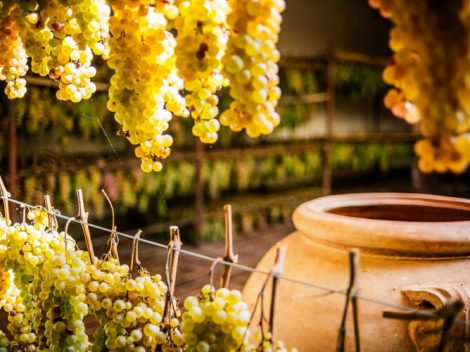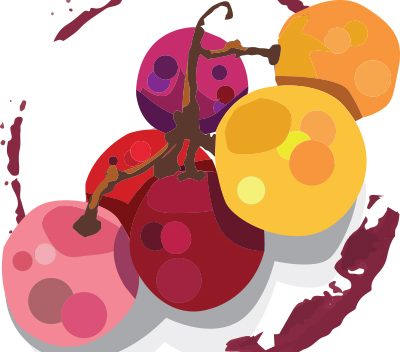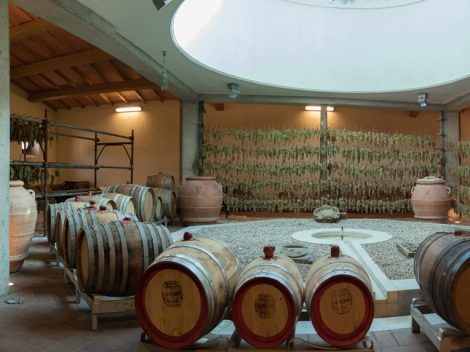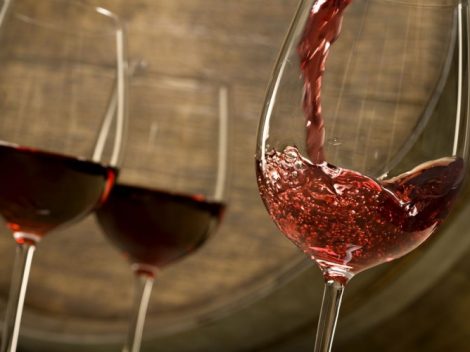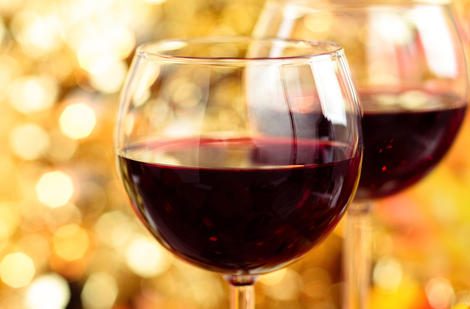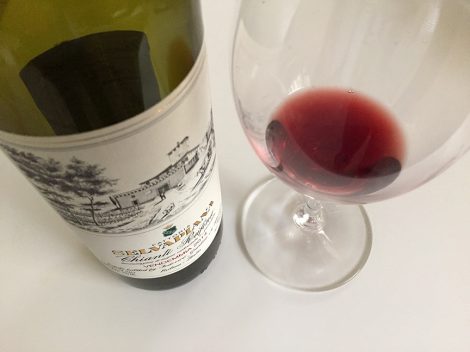Vigneto Erchi
Vigneto Erchi Riserva: Decanter premia l’eccellenza di Selvapiana e del progetto Terraelectae
Il Vigneto Erchi Riserva Chianti Rufina 2018 riceve un'altra importante conferma da parte della prestigiosa rivista Decanter. Con l'assegnazione di un ottimo voto di 95 punti, il vino si distingue per la sua eccellente qualità e viene elogiato da Michael Apstein, un noto giornalista e giudice enologico internazionale. Questo vino prodotto dalla Fattoria di Selvapiana fa parte del progetto Terraelectae, che è un'iniziativa dei produttori aderenti al Consorzio Chianti Rufina, che mira a conferire una caratterizzazione maggiore ai loro vini rispetto a quelli previsti dal disciplinare vigente nella Val di Sieve. Per poter utilizzare il marchio, i vini devono soddisfare alcuni requisiti rigorosi, come essere ottenuti esclusivamente da uve prodotte nella zona di produzione Chianti Rufina DOCG, avere una base ampelografica al 100% di Sangiovese, riportare in etichetta la menzione "Vigna" o "Vigneto" e essere tracciati. Inoltre, i vini devono essere della categoria Riserva, soddisfare i parametri del disciplinare, avere una produzione massima di uva/ha di 70 Qli/ha, un titolo alcolometrico non inferiore al 12,5% vol., 30 mesi di invecchiamento di cui 18 in legno e almeno 6 in bottiglia. L'utilizzo di recipienti tipo "fiasco" è vietato. L'articolo completo che segue fornisce ulteriori dettagli su questa affermazione di qualità. DECANTER PREMIUM 11GEN23 ANOTHER ADDITION TO THE CHIANTI QUALITY PYRAMID: TASTING RÙFINA’S TERRAELECTAE WINES In response to Chianti Classico’s top category Gran Selezione, producers in Chianti Rùfina have added the new category Terraelectae to their quality pyramid, starting with the 2018 vintage. Michael Apstein January 11, 2023 Federico Giuntini Masseti, president of the Chianti Rùfina Consorzio, says that the purpose of Terraelectae – Chianti Rùfina’s new top-tier category- is to highlight the special character of the Sangiovese-based wines from Rùfina’s unique terroir. The producers hope the category will allow Chianti Rùfina to emerge from Chianti Classico’s shadow and be considered a top Tuscan DOCG, like Brunello. Scroll down to see tasting notes and scores for the 10 inaugural Terraelectae wines Chianti Rùfina, the smallest of the sub-regions of the greater Chianti area – just one-tenth the size of Chianti Classico – lies about 30 minutes by car northeast of Florence. With a more rugged terrain and vineyards that lie at a higher elevation, the region has an overall cooler climate compared to Chianti Classico, which gives the wines a more savory and engaging wild component – Gerardo Gondi of Tenuta Bossi, one of Rùfina’s top estates, aptly calls the wines ‘mountain Chianti.’ Faye Lotero, owner of Fattoria Lavacchio, another leading estate, believes that Chianti Rùfina has an advantage with climate change because of its elevation and wind-swept terroir. Meanwhile, the under-the-radar status of Chianti Rùfina is a boon for consumers because the wines deliver more than their prices suggest. Terraelectae requirements The requirements for Terraelectae differ from those of Chianti Classico’s Gran Selezione category, which need not come from a single vineyard, nor be made entirely from Sangiovese. In contrast, to be included in the new Terraelectae category the wines must meet Chianti Rùfina Riserva standards, come from a single vineyard, and be made exclusively from Sangiovese. Other regulations require that Terraelectae be made from a reduced yield (70 quintals/ha) and undergo 30 months of ageing prior to release, 18 of which must be in barrel and six in bottle. The specifics of barrel ageing – size and age of the barrel, and the type and origin of the wood – are left to individual producers. Each producer in Chianti Rùfina – there are only about 20 of them – can select a single vineyard for their Terraelectae bottling. If the wine meets the requirements and receives approval from a group of Chianti Rùfina producers, it will carry the Terraelectae moniker on the label. The producers themselves, not a regulatory authority, have set the criteria for inclusion and judge the quality and character of the wines. Ten producers have designated a Terraelectae with the 2018 vintage: Tenuta Bossi, Colognole, Frascole, Marchese Frescobaldi, Grignano, Fattoria Lavacchio, Fattoria Selvapiana, Villa Travagnoli, Castello del Trebbio, and I Veroni. That three more producers – Podere Il Pozzo, Fattoria Il Lago and Ormae Vinae – opted to wait and release their first Terraelectae with the 2019 or 2020 vintage is either a sign that that the self-policing by producers may be working, or is just an example of inefficiency or indecisiveness. Predicting the future success of new wine projects is hazardous. Who would have predicted the popularity of Bolgheri wines? That said, Terraelectae has at least one thing going for it – SuperTuscan wines are not common in Chianti Rùfina, so the confusion that has arisen in Chianti Classico about whether a producer’s Gran Selezione or their SuperTuscan sits atop the quality pyramid is unlikely to surface. As the tasting notes indicate, the 2018 Terraelectae releases showed very well, with almost all receiving more than 90 points. If the wines remain high-quality and a unique expression of Sangiovese reflecting the distinctive terroir of Chianti Rùfina, the Terraelectae moniker on the label will be useful to consumers. Self-policing by producers will be critical and will ultimately determine whether the Terraelectae designation elevates the entire region or is meaningless. The inaugural Terraelectae wine: Fattoria Selvapiana, Vigneto Erchi Riserva, Chianti Rufina 2018 Fattoria Selvapiana, one of the area’s top producers, designated their 5ha Vigna Erchi, a site that has more iron in the soil compared to their iconic Bucerchiale vineyard. Owner Federico Giuntini thinks the difference in terroir explains why Vigna Erchi produces a bolder wine. Extraordinary elegance and a silky suaveness... Points 95
John Fodera presenta Fattoria Selvapiana in un articolo su Tuscan Vines
John Fodera ha scritto un bellissimo articolo su Fattoria Selvapiana per il sito Tuscan Vines: FEATURE: SELVAPIANA by John Fodera At the foot of the Apennines, in the northeast corner of Tuscany, lies the Selvapiana estate. Here, ancient tradition and history blend in a confluence of wine and ancestry. In medieval times, Selvapiana stood as a watch tower to protect Firenze’s north east border. Eventually, during the Renaissance, the building was enlarged dramatically into a villa that was used by noble Florentine families as a Summer retreat. In 1827, Francesco Giuntini acquired the property and became the first generation of the Giuntini’s to own the estate. Today, winemaker Federico Giuntini and his sister Silvia represent the 5th generation of the family to own Selvapiana. Selvapiana is the preeminent producer within the Chianti Rufina zone. But what is Chianti Rufina? Chianti Rufina Basics Selvapiana calls Chianti Rufina home. But what exactly is Chianti Rufina and how does it differ from Chianti Classico? Chianti Rufina is one of seven sub-zones of the Chianti DOCG – that does not include Chianti Classico; which holds it’s own DOCG. Rufina, pronounced “ROOFina”, was established by Cosimo de’ Medici in 1716. It is the smallest sub-zone of Chianti and when compared to other DOCG, only Carmignano is smaller. Under the rules for Chianti, wines from Rufina must be at least 70% Sangiovese, while from Chianti Classico they must be a minimum of 80% Sangiovese. Foresight & Innovation Although it’s small, Selvapiana has contributed significant innovation to Chianti. In 1978, Giuntini realized the great potential of Rufina and Selvapiana. As a result, he hired Franco Bernabei to be consulting winemaker. Together they created Bucerchiale, a single vineyard Sangiovese Riserva which was an unheard of notion at the time. The wine was an instant success and Bernabei consults to this day. This cycle of improvement and innovation continues. In 2005, the new wine cellar was finished and supplements the existing, historic cellar. Additionally, since 1987, the estate has received organic certification for its vineyards. Selvapiana covers a total of 250 hectares. Approximately 60 are devoted to vineyards which bear the names of the sharecropping farms that once worked the land. The remainder are olive groves and forest. For this feature, I tasted through all the current releases from the Selvapiana Estate. My reviews speak for themselves but to steal my own thunder, I was greatly impressed. I Vini di Selvapiana – All wines Certified Organic Sometimes good comes from bad. A few months back I had received a sample of the 2019 Selvapiana Chianti Rufina. The wine was flat. Dried out, devoid of fruit and hollow. I sat with it for a while to be certain it wasn’t corked. Convinced, I decided to present the wine in a “Twitter Only” review. I was disappointed because in a vintage like 2019, I expected a nice wine. Well, the tweet was spotted by Silvia Giuntini, who requested that her importer reach out to me. This article is the result and benefit of that single tweet. 2019 Selvapiana Chianti Rufina – This is a second tasting of this wine. It clearly portrays the first bottle as somehow flawed, though this is still a straightforward red. In the glass, the light ruby color is nearly transparent. Aromas of cherry, sandalwood and spices are softly presented. Light to medium bodied on the palate with monolithic red berry flavors. Dusty herb and spice notes frame the fruit. This bottle is clearly sound. However, it’s as basic as basic can be. That’s ok, just measure your expectations. 86 points. The 2017 Selvapiana Vigneto Erchi is 100% Sangiovese coming from a 6 hectare vineyard that is about 21 years old. The Erchi farm was purchased in 1998 and planted with vines in 1999. The 2017 is only the second release of this Cru. Deep medium ruby. Deep aromas of black cherry, pipe tobacco, fresh red flowers and crushed clay. Medium to full bodied with ripe, juicy flavors of wild cherry that turn sapid in the mouth. Cigar leaf tobacco, leather and earth notes are gorgeous. Lengthy finish is tinged with cured meat and fennel. Impressive wine. Value is there. 93 points. The 2018 Selvapiana Pomino Villa Petrognano is a deep bright ruby. Brilliant aromas of wild raspberry, red cherry, flowers and sage are spot on. Juicy, fresh cherries on the palate with tobacco, hints of smoke and medium weight tannins that offer grip but moderate with food. This is very nice for the vintage. It could be the elevation and the terroir near the Apennines keep this wine fresher than many other 2018s I’ve tasted. 60% Sangiovese, 20% Cabernet and 20% Merlot. Great value around $21. 90 points. The 2017 Selvapiana Vigneto Bucherchiale is a lovely medium ruby clear to the rim. Textbook Bucherchiale nose. Animale! Salume, wild boar sausage, porcini and crushed cherry are complex and wild. Juicy, sapid wild cherry, fresh fennel, and toasted nuts are medium bodied and persistent on the palate. Fresh, but boy do the tannins clamp down on the finish which is just slightly “hot”. Needs plenty of cellar time like most Bucerchiale do. I’m still holding the 2009 in my cellar. Give this 7+ years at a minimum and then be wowed. 95 points and a steal just under $30. Bucerchiale is sourced from vineyards that were planted in 1968 and 1992. It is 100% Sangiovese and spends 36 months in French barrique before release. The 2016 Selvapiana Fornace hails from vineyards planted in 1994 and 2003. It’s a deep crimson to ruby in color. Crushed cherry and leather dominate on the nose with powdered spices and leaf tobacco emerging too. Really intriguing. Viscous on the palate with ripe cherry, dusty minerals, espresso grind and fennel. Medium to full body. This is very elegant but could still use 1-2 years in the bottle to soften the tannins a bit. Yet, this is deliciously approachable right now. Spends 29 months in barrique before release. 92 points. Overall, there’s no question these wines are exciting and well made. Furthermore, in many cases they represent incredible value given the quality and complexity. Bucerchiale remains a favorite and to me, is an essential in a Tuscan cellar. But we’re not done! Co-Owner and winemaker Federico Giuntini has graciously agreed to sit down with us for a chat. La Intervista con Federico Giuntini TV: Ciao Federico, come stai? FG: Grazie mille Giovanni and thank you for the wonderful article. TV: Piacere mio, iniziamo. These days, many consumers are eager to seek out excellent wines but also wines that are organic. What year did the estate become organic and why did you decide to seek certification? FG: When I first started to work at the estate, during the Summer of 1987, after high school, I asked Francesco to work organic. I saw that it was important then. We had a couple of vineyards where we began the process and after that Selvapiana became fully organic. Regarding certification; we certified the vineyards and olive trees only. TV: Let’s talk about the individual roles at the winery. You’re the winemaker with Bernabei assisting. How are your roles defined? What role does Silvia have in the winery? FG: Selvapiana is still a very small family operation, so roles are not so clear and strict. Silvia is in charge of the office, I mostly work in the vineyards and direct sales. More recently during 2019, my eldest son Niccolo, is now in charge of the cellar and he worked very closely with Franco Bernabei. Franco has helped us since 1978. TV: Besides Chianti Classico, which many of my readers are familiar with, I think the two most recognizable Chianti zones are Rufina and Colli Senesi. Generally speaking, what makes Rufina different from Chianti Classico? FG: Rufina is unique due to its position at the foothill of the Appenines. Because of the altitude, Rufina generally has a longer ripening season, with cooler nights. This promotes balance with a slow ripening of the grapes. But never too ripe. Soils can vary too of course, but the main difference is the location. TV: Bucerchiale is your oldest vineyard with parcels dating back to 1968. It was my first introduction to Selvapiana when I tasted the 1985 vintage. I still remember it. For me, it’s one of the best vineyards in all of Tuscany. What do you think makes it so special? And to that point, I always find “animale” and “cured meat” in that wine. E specially on the nose. Is it the soil that imparts that character? FG: We are really lucky to own such a great spot. The first parcel was planted in 1968 as you say. Then a second parcel in 1992 and a younger one in 2001. The oldest part, mainly because of vine losses and low planting density was ripped up and re-planted just a few years ago. We let the soil rest for 43 years before we replanted. The soil is definitely in that wine. And you’re right – Vigneto Bucerchiale 1985 was probably the best we ever made. In addition to what you say, you can also find the “woodlands after rain” – a sort of earthiness with great minerality. TV: And Bucerchiale is 100% Sangiovese and the estates’s flagship wine. But now you’re producing Vigneto Erchi which is also 100% Sangiovese. What is the main difference between the two? In my tastings above, I suppose I’d generally say that Bucerchiale is a bit more rustic while Erchi seems more polished. What do you think of that? What are the differences in altitude between the two vineyards? FG: Vigneto Bucerchiale is the project of Francesco Giuntini, with a young Franco Bernabei. And even Luigi Veronelli was involved then who encouraged the planting! Vigneto Erchi is the project of my generation. We bought the land in 1998 and planted the vineyards in 1999; just 6 hectares. We waited until the vines reached a good age and selected a new cru. Vigneto Erchi is in the municipality of Pontassieve in a kind of conca d’oro (not so great as the one in Panzano!) It sits next to I Veroni, Poggio a Remole, Il Capitano e Cerreto Libri. Soils there have more calcareous limestone and much more iron than Bucherchiale which is mostly clay with limestone. Bucherchiale is higher at about 200 meters while Erchi sits between 150-200 meters. The two make for an interesting comparison. TV: Let’s chat about vintages for a moment. Which year do you think was the most difficult vintage you’ve ever worked and what made it so hard? Contrarily, which was the easiest and why? FG: Well, my first one was 1987 and was really, really complicated. Lots of grapes (High yields) even though we green harvested a lot that year. There was lots of rain during the harvest as well and lots of Botrytis. 1992 was also very complicated. Those are 2 years when no Bucerchiale was made. Then I think 2013 and 2019 were probably the 2 easiest. Conditions were perfect in our area. TV: Definitely 2019! I’ve had discussions with a lot of winemakers across Italy and they are all praising that vintage. 2019 comes with great fanfare so what do you think of it? FG: Ha! Giovanni, the best thing I can say is that I hope to see another quality vintage like this! TV: Regarding vintages, good and bad, I’m always discussing the changing climate with winemakers. Hotter and drier Summers are forcing them to make changes to the way they farm. Lying further to the north, and under the protection of the Apennines, what decisions have you needed to make in order to combat the warming climate? FG: Many things have been changed and there is much more to be changed. We can not move the vineyards and so we have to play where we are! We practice later pruning to delay bud break, so you avoid Spring frost and also you can delay ripening this way. We use cover crops and manure to increase organic substance and have better microlife to the soil and reduce water stress to the vines. We work the soils deeper and more aggressively during winter to prevent the soil from becoming compacted. Also, canopy management has changed. We don’t pull away the leafs any more; no hedging. We like to keep the grapes more in the shade. Last but not least, before the big heat waves we spray products that help to reduce the temperature of the leafs, like caolino (white-clay and algae). TV: Wow! That is a ton of intervention, it’s amazing. FG: Well, every vintage is different certainly, but we have to be prepared to react given what nature provides us. We work all naturally so taking care of the vines and soils the best we possibly can will reduce the chance that we will have problems later. TV: Well, thank you so much Federico. In wrapping up, tell us what’s new at Selvapiana? What’s exciting? What would you want my readers to know that I haven’t brought up? FG: New is the new generation! They are slowly taking over. I am not too old but again, we have to be prepared! Niccolò is already working 100% in charge of the cellars and now he’s doing a lot in the vineyards. Plus, my daughter Rebecca is starting to help at the wine shop. TV: Grazie tanto Federico – I truly appreciate your time and your passion. I know my readers do as well so thank you for enlightening us. FG: Grazie a te Giovannin. I hope we see each other soon.
Recensioni in anteprima dei vini Selvapiana su Falstaff Tasting Toscana Centrale
I vini Selvapiana sono stati recensiti anche da Falstaff e sono inclusi nella rivista Falstaff Tasting Toscana Centrale, presto in edicola nella versione cartacea. "BIO Vigneto Bucerchiale Chianti Rufina Riserva DOCG 2016 Selvapiana DIAM: Tappo in granulato di sughero pressato. Rosso rubino potente e brillante con una sottile sfumatura di color granato. Aroma molto intenso ed emozionante di frutta matura, in particolare ciliegia e prugna, con qualche sentore di tartufo nero. Al palato si diffonde, molto forte il tannino, succoso e denso, si apre in più strati, nel finale deciso con note terrose, si avverte molto tabacco. BIO Vigneto Bucerchiale Chianti Rufina Riserva DOCG 2017 Selvapiana NK: Tappo in sughero naturale. Rosso rubino brillante e ricco. Si apre con note di resina e bosso, poi subentra la ciliegia. Compatto e strettamente intrecciato nell'approccio e nella rotta, mostra un tannino molto potente, aderente e avvincente, abbinato a finale dolce fondente, sostanzioso e lungo. Vigneto Erchi Chianti Rufina DOCG 2016 Selvapiana - 14% in volume NK: Tappo in sughero naturale. Rosso rubino luminoso con un cuore frizzante. Nobile e invitante aroma di chiodi di garofano, ciliegia e prugna e un pizzico di incenso. Succoso e presente al palato, si apre con un sottotono minerale, ricco, col tannino potente che perdura a lungo." Inoltre, tutte le note di degustazione saranno disponibili online sul sito http://www.falstaff.com/toskana-2021 fals_AT_2101_Tasting Toskana
Recensione e punteggio per Vigneto Erchi 2016 di Kerin O’Keefe su Wine Enthusiast
Il nostro Selvapiana Chianti Rufina Vigneto Erchi 2016 ha ottenuto la seguente recensione e punteggio su WineEnthusiast: "Perfumed and all about finesse, this focused red (the result of a long-term project) is the latest addition to the firm's stellar lineup. It opens with enticing aromas of fragrant purple flower, wild berry, truffle, baking spice and a whiff of crushed herb. Smooth and radiant, it delivers crushed cherry, raspberry compote, mint and star anise flavors set against taut polished tannins. Bright acidity lends balance and tension. Drink 2021–2036. KERIN O’KEEFE RATING 95 DESIGNATION Vigneto Erchi VARIETY Sangiovese APPELLATION Chianti Rufina, Tuscany, Italy WINERY Selvapiana"
Vigneto Erchi 2017 premiato dall’Associazione Italiana Sommelier
Il nostro vino SELVAPIANA CHIANTI RUFINA VIGNETO ERCHI RISERVA 2017 ha ottenuto il massimo riconoscimento delle QUATTRO VITI nella settima edizione della Guida ai Vini d’Italia VITAE, edita dall’Associazione Italiana Sommelier. Ricordiamo che la consueta degustazione di tutti i vini premiati e la consegna degli attestati ai Produttori, prevista a Roma presso la Nuvola di Fuksas per sabato 28 novembre 2020, quest’anno purtroppo non sarà realizzata in presenza.
Vendemmia 2020
Anche quest'anno alla Fattoria di Selvapiana abbiamo concluso con soddisfazione la raccolta dei frutti delle nostre vigne. In questa galleria di foto vi raccontiamo una storia che si tramanda da generazioni e che si rinnova ogni anno
Nuove recensioni e aggiornamenti di Antonio Galloni su Vinous
Antonio Galloni ha recensito su Vinous i seguenti vini di Selvapiana: 2018 Chianti Rufina - 92 punti 2017 Chianti Rufina - 93 punti 2016 Chianti Rufina Vigneto Erchi – 95 punti 2016 Chianti Rufina Vigneto Bucerchiale – 94 punti 92 pts Selvapiana 2018 Chianti Rùfina Chianti Rùfina, Tuscany Red wine from Italy Drinking window: 2023 - 2038 Selvapiana's 2018 Chianti Rufina is exquisitely beautiful. A wine of translucence and character, the 2018 captures the essence of the vintage in spades. Dark cherry, blood orange, cinnamon, rose petal and mint are all laced together in the glass. The 2018 is effortless and silky, with striking aromatic presence and exceptional balance. This is so impressive. Antonio Galloni. Tasting date: September 2020 93 pts Selvapiana 2017 Chianti Rùfina Chianti Rùfina, Tuscany Red wine from Italy Drinking window: 2023 - 2037 The 2017 Chianti Rufina is fascinating to taste next to the 2018. It is richer and more intense, yet never strays too far from its Rufina roots. Sweet red cherry/raspberry fruit, chalk, mint and white flowers are some of the aromas and flavors that start to open with a bit of time in the glass. While the 2017 offers notable fruit density and volume, the tannins also have an element of firmness that is going to require cellaring or a good bit of aeration. It is another fabulous wine from Selvapiana. Antonio Galloni. Tasting date: September 2020 95 pts Selvapiana 2016 Chianti Rùfina Vigneto Erchi Chianti Rùfina, Tuscany Red wine from Italy Drinking window: 2023 - 2041 A new wine in the range, the 2016 Chianti Rufina Vigneto Erchi is off the charts. The purest essence of Sangiovese emerges from a wine that combines power with translucent finesse. Bright acids and citrus accents perk up the red Sangiovese fruit. Initially a bit austere, the 2016 gains volume with time in the glass. The Erchi emerges from a relatively new parcel for the state planted with cuttings from Bucerchiale. Compared to that wine, the Erchi has a much more red-fruited profile and also appears to handle aging in French oak better. The 2016 is a stellar debut. Don't miss it. Antonio Galloni. Tasting date: September 2020 94 pts Selvapiana 2016 Chianti Rùfina Vigneto Bucerchiale Chianti Rùfina, Tuscany Red wine from Italy Drinking window: 2026 - 2041 The 2016 Chianti Rufina Vigneto Bucerchiale is a dark, brooding wine. Swaths of tannin make a first impression. Gradually, black cherry, plum, lavender, cloves, leather and menthol start to emerge. This potent, massively tannic Chianti Rufina is going to need a number of years to come around. There is plenty of depth, but the elements are totally put together. The 2016 finishes with tremendous substance and gravitas. I expect the 2016 will always remain a brute. Antonio Galloni. Tasting date: September 2020
Fattoria di Selvapiana vince la BOTTIGLIA di Slow Wine 2021
"La guida Slow Wine 2021 vi ha assegnato i seguenti riconoscimenti: BOTTIGLIA (simbolo assegnato alle cantine che hanno espresso un’ottima qualità per tutte le bottiglie presentate alle nostre degustazioni) TOP WINE – VINO SLOW: Chianti Rufina Vigneto Erchi 2017 (Top Wine che, oltre ad avere una qualità organolettica eccellente, riesce a condensare nel bicchiere caratteri legati a territorio, storia e ambiente. L’attribuzione di questo simbolo implica l’assenza di diserbo chimico nei vigneti. Il Vino Slow risponde anche al criterio del buon rapporto tra la qualità e il prezzo, tenuto conto di quando e dove è stato prodotto) Non vi nascondiamo che quest’anno sia stato molto complicato realizzare la guida, ma riteniamo che il lavoro che abbiamo svolto sia stato puntuale, attento e decisamente innovativo. Slow Wine 2021 sarà la prima guida sia cartacea sia digitale: i contenuti, infatti, della guida si sono arricchiti di oltre 900 video interviste, accessibili da un QR Code pubblicato al fondo della scheda. Un atto rivoluzionario per una guida cartacea che il pubblico di appassionati e professionisti del settore saprà apprezzare."
Recensioni di Master of Wine Mary Ewing-Mulligan per Wine Review Online
Tre vini di Selvapiana sono stati recensiti da Master of Wine Mary Ewing-Mulligan per Wine Review Online. “Three Chiantis from an Outlying District By Mary Ewing-Mulligan Jul 20, 2020 Fattoria Selvapiana, Chianti Rufina 2018, Vigneto Bucerchiale 2016 and Vigneto Erchi 2016 (Dalla Terra Winery Direct, $19, $35 and $50): These days, Chianti is my favorite wine that I hardly ever drink. As much as I am a big fan of Chianti and Chianti Classico, I’m not dining out these days and therefore not ordering it in restaurants, where it is often the ideal choice. That and the urge to explore new and different wines have left Chianti out of my repertoire of late. Consider this column the beginning of my reparation. The overwhelming majority of my favorite Chianti wines are actually Chianti Classico, a separate wine once encompassed within the broader name of “Chianti.” Within the Chianti category per se, Fattoria Selvapiana is the star. It hails from the smallest of the Chianti subzones, Rufina, in the northeastern part of the territory. Here the soils are similar to those of Chianti Classico, but a more northern location and elevations that can range from 200 to 700 meters (655 to 2300 feet) give the wines delicacy and tautness that is particular to the region — particular to Selvapiana, in any case, which is the zone’s finest producer. Among Selvapiana’s four current releases, its basic Chianti Rufina 2018 is the least expensive ($19), the easiest to enjoy, and the readiest to drink. Despite these connotations of “lesser than,” it’s the wine I really want to drink, especially now, in July. Its nose is surprising fruity and vibrant for a Chianti; it suggests fresh red cherries, dried herbs, fresh mint and thyme, and licorice. In your mouth, the wine is dry and medium-bodied, a light-ish red with a spine of acidity and just a medium amount of tannin, with fruity flavors similar to its aromas. A noteworthy aspect of this wine is how well it “hangs” in your mouth — fruitiness in the front, acidity up the middle and a combination of fruitiness and textured tannin in the back. It’s a complete wine that delivers all across your mouth. Did I mention the price, $19? The 2018 Chianti Rufina is 95% Sangiovese with some Canaiolo, Colorino and Malvasia Nera. It is aged in large French-oak barrels, and only briefly. The newest wine in the Selvapiana lineup is 2016 Vigneto Erchi Chianti Rufina ($50). It’s the opposite of Selvapiana’s basic Chianti Rufina in the sense that it’s the richest Chianti, the most ageworthy and the most expensive. When Selvapiana’s owners, the Giuntini family, purchased this land in 1999, it was the first purchase they had made since 1897! The 2016 is the first release from this vineyard. On the nose, this wine is complex but tight, showing savory mineral notes that combine with concentrated red cherry, spicy oak and woodsy herbal hints. After that tight nose, the wine seems surprisingly rich in flavor when it enters your mouth, all dark berry fruit but in a truly dry wine, not at all the sort of rich, fruity flavor many wine drinkers might be accustomed to. The wine has high acidity and an abundant amount of velvety tannin, but not enough tannin to overwhelm that fruit. Again, there’s balance happening here between the aromatics and the structure. The wine maintains the signature structure of a Chianti and yet delivers fruitiness worthy of not only the fine 2016 vintage, but also an apparently fine vineyard and an enlightened winemaking regime. This wine is 100% Sangiovese, from vines that were a massale selection from the Bucerchiale vineyard. It aged 18 months in French oak barriques. Between these two wines is the 2016 Selvapiana Vigneto Bucerchiale Chianti Rufina Riserva ($35). This is the winery’s flagship, a single-vineyard, all-Sangiovese wine has a track record of aging beautifully. Stylistically it is closer to the Chianti Rufina than the Vigneto Erchi because it is light on its feet and has an uplifted, fresh energy, but is considerably more concentrated. Its aroma gives me red cherry, a bit of raspberry, a whiff of chocolate and spicy, smoky oak. Although weightier than the basic Rufina, this wine is still medium-bodied, with high acidity (of course) and silky flesh, at least until the wine’s raspy tannins register on your tongue. Even then, a silkiness lingers and carries through to the finish. When the wine has some aeration, the tannin doesn’t really need a few years to integrate, but in a few years this wine will be all the better, while remaining classically Chianti Rufina. Traditionally, Vigneto Bucerchiale is considered Selvapiana’s finest Chianti, but the emergence of Vigneto Erchi might be shuffling the cards. Bucerchiale is a wonderful, classically styled Chianti with a proven pedigree. But for me in this moment, choosing between the drama of Vigneto Erchi and the joyful appeal of the basic Chianti Rufina has me speaking about Bucerchiale as if it is an also-ran. Such is the sad fate of the middle child. 2018 Selvapiana Chianti Rufina, 90 Points 2016 Vigneto Bucerchiale, 92 Points 2016 Vigneto Erchi, 93 Points” http://www.winereviewonline.com/MEM_on_Selvapiana_Rufina.cfm
Le recensioni di luglio dei vini Selvapiana su Master of Wine Christy Canterbury
Time Flies: Celebrating New & Old Wines at Fattoria Selvapiana One hundred years passed between the Giuntini family's last two purchases of land for vineyards, 1897 and 1997. So, the 19-year wait to produce the first single vineyard wine, Vigneto Erchi, from that new plot was relatively quick. (The family planted the vineyard in 1999.) In the same year that Fattoria Selvapiana welcomed this new wine to its stable, the winery also celebrated the 300th harvest since Pomino's first quality decree, or bando, by Grand Duke Cosimo III de’ Medici in 1716. The duke defined this area to protect the quality of wines being shipped to England (in place of French claret during the various wars of those days) for increasingly higher prices and volumes. Time flies, and life is too short to drink bad wine. With any of the Selvapiana wines, you won't waste a sip! 92 Fattoria Selvapiana 2016 Vigneto Erchi Chianti Rùfina DOCG 14% $50 The south-facing Erchi vineyard is planted with massal selection Sangiovese from the Bucerchiale vineyard. There is a fascinating, stern elegance in the Vigneto Erchi. The nose is tight and reserved. (Give it a hearty decanting.) The palate is similar though there is a pop of sweet cherry fleshiness in the mid-palate. The tannins are broad and grainy, and while their initial attack feels as though they may be relentlessly drying, the mid-palate plumpness diffuses them nicely. The concentrated, beautifully ripe fruit pivots into a lingering finish of dried mulch and exotic spice with a lightly leathery finish. Compelling now, this needs and deserves time. It has the structure and stuffing to age very well. Drink: 2023-30 94 Fattoria Selvapiana 2016 Vigneto Bucerchiale Chianti Rùfina DOCG Riserva 14.5% $35 This pure Sangiovese Riserva from Selvapiana's best vineyard is made only in the best vintages. (See the 2014 and 2015.) It always impresses me that a wine with such pedigree can be so accessible at such an early age. This 2016 is raring to go with its enthralling aromas of roasted meat, briar fruits and mulch. The attack is smooth - almost lush for the Rùfina area - with ripe fruits. To back up this generously-bodied palate is Rùfina's telltale chirpy acidity that creates a waterfall of refreshment on the back palate. Throughout, the lightly coarse and sticky tannins mold onto the palate to create a mouth-filling and dignified Sangiovese. The fruit is impressively powerful and forward - not surprising given the vintage, but the structure is unrelentingly harmonious. Drink: 2020-31 91 Fattoria Selvapiana 2015 Pomino Rosso DOC Villa Di Petrognano 14% $21 While Pomino is a very small denominazione today, so small that only two producers use the DOC, it once defined a much larger area, including Chianti Rùfina, Chianti Classico, Carmignano and Val d’Arno di Sopra. This wine's dominant variety, Sangiovese (60%), is mostly noticeable in the orange-tinged, ruby color and the floral, strawberry-perfumed attack. Then this Pomino Rosso's Bordeaux contributors - equal parts Merlot and Cabernet Sauvignon - take over the palate flavors and feel. The mid-palate is full-bodied and supple thanks to the Merlot and the ripe nature of the 2015 vintage. The somewhat husky tannins hail from the Cabernet Sauvignon. The pleasantly earthy and minerally finish lingers with liveliness. There is good balance and integration here, and with the full-blast personality of the Bordeaux varieties, the wine could certainly stand to relax a bit in bottle. Still, it's ready to be enjoyed if you like your wines young and vigorous. If you're interested in putting away a few bottles to see how wines age, this should do nicely for the first half of this decade and even beyond, for a very modest sum! Drink: 2020-26 90 Fattoria Selvapiana 2018 Chianti Rùfina DOCG 13.5% $19 Chianti's Rùfina sub-zone of is arguably the best of those outside the Classico area, and this label consistently shows why. Yet again, this is terrific value for the money, showing off Rùfina's pretty and poised aromatics with Sangiovese's tantalizing red fruit tones and light earthiness. This vintage's aromas showcase rose petals, cigar wrapper and red currants. The medium-bodied palate is elegantly balanced between its pristine, energetic fruit, its lightly mouthcoating texture and elegant, talc-like tannins. There is zero evidence of oak use thanks to the employment of large, 25-30 hl French casks. This is the epitome of elegant, high altitude Chianti Rùfina. This vintage's finish is lighter than the 2015 and 2016, suggesting that this is more of an early- to-mid-range wine. Drink: 2020-24 http://christycanterbury.com/publishedhere/2020/7/10/time-flies-celebrating-new-amp-old-wines-at-fattoria-selvapiana


